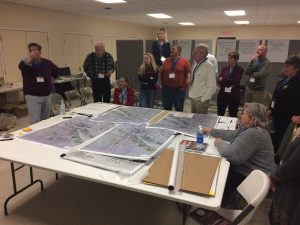Spotlight: Seeking Citizen Buy-In and Community Voice in Limon
Community: A word so thoroughly used in the nonprofit sector that it often fails to evoke a clear image or commonly held definition. Limon, Colorado – 100 miles east of Denver on I-70, is on the road to redefining their community. The town of 1,800 is a frequent stop for long-distance truckers and families on road trips, fittingly named the “Hub City” due to the convergence of several key transportation routes. For many of us outside the eastern plains, Limon evokes an image of looming truck stops and rows upon rows of wind turbines filling the horizon.
 I recently had the opportunity to attend the Citizen’s Institute on Rural Design (CIRD), after Limon was chosen as one of 6 towns across the country to go through an intensive, 3-day community planning process. CIRD is a collaborative program of Project for Public Spaces, Orton Family Foundation, USDA Rural Development, and National Endowment for the Arts. Leadership in Limon, including city officials, Lincoln County Economic Development, the Chamber and Tourism boards, and community stalwarts such as the local FFA and Heritage Society, identified wayfinding and trails as key priorities for future community development. State resource providers, including government agencies, private foundations, and topical experts, were invited to be a part of the process.
I recently had the opportunity to attend the Citizen’s Institute on Rural Design (CIRD), after Limon was chosen as one of 6 towns across the country to go through an intensive, 3-day community planning process. CIRD is a collaborative program of Project for Public Spaces, Orton Family Foundation, USDA Rural Development, and National Endowment for the Arts. Leadership in Limon, including city officials, Lincoln County Economic Development, the Chamber and Tourism boards, and community stalwarts such as the local FFA and Heritage Society, identified wayfinding and trails as key priorities for future community development. State resource providers, including government agencies, private foundations, and topical experts, were invited to be a part of the process.
For many of us on the State Resource Team, participating in the Institute meant re-familiarizing ourselves with Limon and its unique character. Once you get about a mile off the interstate, you’ll find the true town center. During my trip, I heard several references to the historic tornado that ripped through town in 1990 and redefined Limon, both its infrastructure and culture. What struck me while meandering through downtown, was the notable absence of key community assets. I had to really dig to find Limon’s Heritage Museum & Railroad Park, easily its most revered destination. Similarly, I only stumbled upon the peaceful walking trail around the cemetery after hearing it described in our planning meetings. These assets, while present, were hidden from view for many visitors. It was clear why town leaders found wayfaring and signage so important for continued economic development.
 The three-day event was full of information sharing, strategic planning, and community meetings. At least 100 people participated at some point, including Limon citizens who provided feedback each evening on the drafted trail and signage plans. It was enlightening to listen to Limon’s leadership waver between prioritizing projects for the “community” – such as bike lanes to schools and safe routes to recreation areas – or projects for “visitors” – wayfaring to get travelers off I-70 and into town, stimulating economic development.
The three-day event was full of information sharing, strategic planning, and community meetings. At least 100 people participated at some point, including Limon citizens who provided feedback each evening on the drafted trail and signage plans. It was enlightening to listen to Limon’s leadership waver between prioritizing projects for the “community” – such as bike lanes to schools and safe routes to recreation areas – or projects for “visitors” – wayfaring to get travelers off I-70 and into town, stimulating economic development.
This delicate balance between preserving traditional community and investing in new strategies for development is a constant discussion in rural Colorado. Cornerstone businesses and service providers, like Lincoln Community Hospital in neighboring county seat Hugo, struggle to adapt and remain viable in a county with just over 2 people per square mile. The Heritage Museum, which is certainly worth a visit on your next trip east, is only open a few months of the year due to staffing and resource needs. The community has voiced frustration and exasperation at these continued resource gaps – overwhelmingly electing an outsider candidate for President, who vehemently called for more investment in rural communities. As Colorado’s nonprofits, foundations, and public agencies continue to expand investment and resources in rural communities, we must also be willing to have this conversation. How do we strike a balance between respecting rural tradition and challenging communities to seek out creative solutions? Convening and empowering local communities is a great place to start.
Leah Rausch
Director of Rural Partnerships
